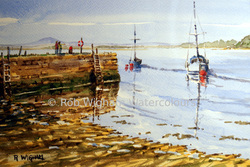 I've been a bit quiet lately, and I thought I'd explain why. First off, my wife has been poorly with a back problem, and that has meant I've had to do a little bit extra around the place to look after her. Poor girl, she's been in lots of pain. I'm very glad to report she's getting better now after seeing an osteopath. It's actually been nice having her around all the time, I just wish it could have been under nicer circumstances! Our new puppy, Zena, is also growing up nicely and demanding lots of attention and time! But the main reason I've been quiet is that I've been busy with commission work, and I'm afraid that I can't publish any of it! However, I'm now almost at the end of that and I'm looking forward to getting back to doing my own work again. Don't get me wrong, some of the commission work involved techniques I haven't used before, and they worked out really well. One of those techniques was the use of gouache, a kind of opaque version of watercolour. One of the key beauties of watercolour is that, by and large, it's transparent. I love building up colours with washes of different colour. For example, if you mix red and blue paint in the palette, you'll get purple, yes? But put a transparent wash of red on the paper, let it dry and follow it up with a thin wash of blue and you'll get... a blue with a red glow behind it! It's beautiful! However, one of the problems is that because you can't cover a dark colour with light, you always have to work from light to dark in a watercolour. It's OK - this is something you get used to, and I often find myself looking at a scene and working out what colours I'd use, and in what order. What's cool about using gouache is that it allows you to add highlights over dark. You can also mix it with watercolour to make different colours - so for all you watercolourists out there who fancy a go with gouache, if you have a full range of watercolours, all you need is white! Mostly, in watercolour, if you want white in your painting, you have to save it, which means painting around it with every wash. You can use masking fluid but that's difficult to apply accurately - it tends to look 'blobby'. There's no substitute for saving whites, but I've found over the last few weeks that in some circumstances, white gouache can add a beautiful sparkle. I wish I could show you the sort of results I mean, but I can't. Maybe I'll use some gouache in my work for open sale in the next few weeks and you'll see then! In the meantime, it's back to my own work tomorrow - Killer Whales, anyone?
0 Comments
Leave a Reply. |
AuthorA professional artist living and working in the beautiful north of Scotland. My work is realistic and quite traditional, though strongly interpretational in nature. My inspiration is the beauty of Nature, and the wonderful colours and moods she shows everywhere. Archives
April 2022
Categories |
 RSS Feed
RSS Feed